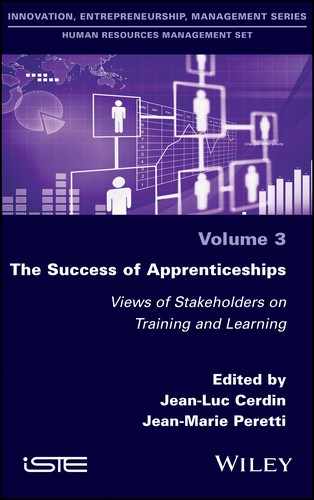Book Description
Apprenticeships can offer apprentices, their teacher-tutors and business apprenticeship supervisors experiences that are rich in knowledge.
The Success of Apprenticeships presents the observations and opinions of 48 actors regarding apprenticeships. These testimonies recount how apprenticeships allowed them to improve their expertise, their professional practices and their organization skills. This book also examines how their interactions in the work/study process allowed them not only to develop the skills of apprentices, but also the skills of those who accompanied them – the teacher-tutors and the business apprenticeships supervisors.
The creation of an authentic community of apprentices subscribes to the formation of an ecosystem of learning, in which each individual harvests fruits in terms of the development of their personal abilities.
Table of Contents
- Cover
- Foreword – ESSEC Business School: The Pioneering Spirit
- Foreword – Learning by Doing
- Introduction
- PART 1: The Challenges of Apprenticeships in the Training System
- 1 Apprenticeship Training: A Dedicated Educational Engineering
- 1.1. Introduction
- 1.2. Why propose an apprenticeship? Evidence, an ambition, a reasoned choice or an opportunistic behavior?
- 1.3. Validation of the apprentice’s acquisition of skills: know-how, soft skills and practical knowledge
- 1.4. The French model: economic balances and their complexity
- 1.5. The governance of an apprenticeship program: power issues?
- 2 Apprenticeships: The First Learning Experience
- 3 Innovation at the Heart of the Company and Apprenticeship Methods
- 4 The Leader-Entrepreneur in an Apprenticeship Position
- 5 Reinventing the Promise of Work-linked Training… Or an Initiatory Journey Towards Agile Professionalism and Postural Learning
- 6 Apprenticeships, a “Springboard” to Professional Integration?
- 7 Reflexivity and Management Apprenticeships
- 7.1. Introduction
- 7.2. From reflexivity to reflexive manager?
- 7.3. Initial training: from a “classical” learning posture to a reflective posture
- 7.4. In continuous training: a pre-existing professional activity to facilitate the reflective process
- 7.5. APEL: strong reflexivity in the “being” dimension
- 7.6. References
- 1 Apprenticeship Training: A Dedicated Educational Engineering
- PART 2: Perspectives of Apprenticeship Actors
- 8 The Birth of Apprenticeships: A Marker of the Pioneering Spirit of ESSEC
- 9 Cross-fertilization of Stakeholders’ Views on the Key Factors for the Success of an Apprenticeship Pathway
- 10 Beneficiaries of the Apprenticeship Process
- 11 The Value of an Apprenticeship in Business School Training: The Apprentice’s Perspective
- 12 Reflections on “Apprenticeships”
- 13 Apprenticeships at ESSEC: Practice
- 13.1. Introduction
- 13.2. Presentation of the apprenticeship system in the curriculum (MiM) of the ESSEC Business School
- 13.3. Students’ motivations for getting involved in the scheme
- 13.4. Organization over time
- 13.5. The geographical and intercultural dimension
- 13.6. The experience of trust in the professional environment
- 13.7. Challenges to consider
- 13.8. Conclusion
- 14 Sandwich Course Training in Higher Education in an Island Territory
- 14.1. Introduction
- 14.2. The system of sandwich course training at the University of Corsica, adapted to the context of an island economy
- 14.3. The conception of ministerial surveys on the follow-up of the professional integration of work-based students enrolled at the University of Corsica
- 14.4. Conclusion
- 15 Entrepreneurship Master’s Degrees in a Business School: What Added Value for the Company?
- 15.1. Introduction
- 15.2. Entrepreneurial culture in Business Schools: the case of EM Strasbourg
- 15.3. The apprentice in post-graduate entrepreneurship as a “strategic relay” within the company
- 15.4. Apprenticeships, a lever for developing the company’s dynamic capabilities
- 15.5. Conclusion
- 15.6. References
- PART 3: Elsewhere in the World
- 16 German Dual Training through Apprenticeships: An Exportable Model?
- 17 Apprenticeships in England
- 18 Beyond Meeting the Needs of the Economy, Reconnecting Work and Values: The Indian Apprenticeship Experience
- 19 Apprenticeship Management in Africa: The Case of Madagascar
- 20 Training African Managers and Combating the “Brain Drain”
- 21 Japanese Style Learning: Learning-by-doing in Japan, a Concept Still New to Management
- 22 The Chinese Apprenticeship Model: The Spirit of Craftsmanship
- PART 4: Perspectives on Apprenticeships
- 23 Apprenticeship Reform: An Asset for Renewing Our Social Model
- 24 Thinking About an Ecology of Learning, from People to the Organization
- 25 Apprenticeships: Conversation as a Lever
- 26 Paradigm Shift: All Learners
- 27 Job Quality: A Challenge for the Effectiveness of Higher Education Apprenticeships
- 28 All Apprentices: A Necessity
- 29 Research on Apprenticeships
- List of Authors
- Index
- End User License Agreement
